Infected hair follicles medically referred to simply as folliculitis results from the bacterial infection of the hair follicles. Poor methods of shaving is the most common cause of bacterial infection.
An infection of the hair follicles is common on any of the body parts with hair. The inflammation of these follicles is, however, common in the beard area, arms, back, legs and buttock. Here is an insight on how to remove and treat infected follicles with home remedies.
Staphylococcus aureus is the organism responsible for the bacterial infection of the hair follicles. When it invades the skin, it causes 3 different clinical patterns of infection, this is according to the international foundation for dermatology. The three patterns are:
- Folliculitis, a superficial infection of a single hair follicle
- Furuncles which is a deeper infection of the hair follicles and
- Carbuncles which represent the coalescence of a number of furuncles
Infected hair follicle picture
The appearance of an infected hair follicle will vary. Depending on how severe the infection is, folliculitis will appear as either tiny pustules, often in groups on hair-bearing regions of the body, it is also possible for lesions to be seen on the skin. For a deep infection causing furuncles or boil, an infection of the follicle will appear as red, tender and raised lesions.
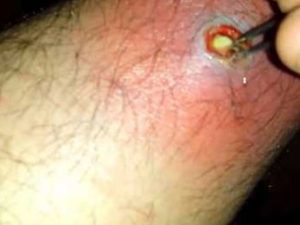
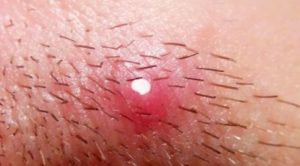
In this article, we have provided you with some images to help you understand how an infected hair follicle will appear. The images provided are only to be used for illustration and not as a substitute for a professional health diagnosis. Here are some images of how an infected hair follicle will look like.
Infected hair follicle in armpit
An infection of the hair follicles as said can occur on any part of the body with hair. On our bodies, some sites are more prone to this infection than others. Bacterial infection on armpit is more common. Bacteria grows in a very diverse condition that explains why they occur nearly everywhere. Although they are good at adapting their environment, certain condition promotes their growth more than others.
In such cases, it is common to experience the infection is certain parts of the body more than others. The warm and moist environment in the armpits provides a conducive environment for the growth and reproduction of bacteria. Most disease-causing bacteria will thrive in warm temperatures especially those close to the body. Bacteria also need water to grow that is why moist armpits are prone to bacterial growth.
There are different types of folliculitis that could occur in the armpit. Hot tub folliculitis also known as pseudomonas folliculitis is caused by pseudomonas bacteria. You may be exposed to this bacterial infection from many places. Common sites of infection include hot tubs and heated pool in which the chlorine and pH levels are not well regulated. With this kind of infection, you may develop a red rash and round itchy bumps in armpit some days after exposure to the virus. Left untreated the bumps could develop into a small pus-filled blister.
Infection of the hair follicle in the armpit can also occur after shaving. In this case, this kind of bacterial infection is referred to as barber’s itch. Medically known as pseudofolliculitis barbae, this is inflammation of the hair follicles caused by ingrown hair. People who get bikini waxes may develop this kind of bumps. With time the condition may leave dark raised scar
Infected hair follicle on scalp
An infected hair follicle or folliculitis can occur on any part of the body. Scalp folliculitis is thus an inflammatory disorder of the hair follicle in the scalp. An infected hair follicle on the scalp is also known as acne necrotica miliaris or Propionibacterium folliculitis.
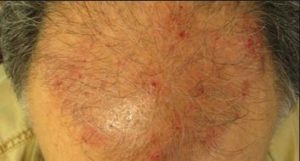
For most people with scalp folliculitis, the infection is in most cases characterized by small, very itchy pustules on the scalp. The number or lesions will vary, some people may have very many of them whereas other may have just a few. Due to severe itching, these lesions are very hard to leave alone.
The cause of infected hair follicles on the scalp is not well understood. The infection is generally considered to be an inflammatory reaction to components of the hair follicle particularly microorganism such as bacteria. On the scalp, this infection is most likely to be caused by:
- Bacterial infection
- Yeast infection
- Mites
In both adults and children, an infection of the hair follicles on scalp should be treated by washing the scalp with a mild normal shampoo as often as desired. You can also use antidandruff shampoo containing antifungal agents. If need be, a conditioner can be used. Keeping your scalp clean reduce the chance of the infection spreading to other parts, relieves the itching and helps get rid of bacteria or other microorganism causing the infection of the scalp.
Topical and oral antibiotics can be used in cases of severe bacterial infection on the scalp. If the irritation, itching, and inflammation persist for more than a week, have a professional health care look into it.
Infected hair follicle on leg
Infection of the hair follicles can occur on any part of the body. Though rare, folliculitis could also occur on legs. The damaging of the skin and hair follicle leading to this kind of infection will in most cases be as a result of poor shaving and wearing tight ad restrictive clothes, especially during exercises.
Unless the infection is causing too much itching or irritation, the infection is considered mild and can be managed and treated at home. Apart from shaving, folliculitis or inflammation of the hair follicles on the leg can be caused by other medical condition such as inflammatory skin condition.
Inflammation of the skin is a body’s attempt at self-protecting. The aim being to remove harmful stimuli, this would include damaged cells, irritants or pathogens. When something harmful or irritating affects a part of the body (leg), the body will become inflamed as a biological response to try and remove it.
Infected hair follicle on legs can be caused by the following:
- Bacterial infection
- Irritation which happens when the hair grows after waxing, shaving or plucking
- The infections or inflammation of the hair follicles on legs can also occur due to contact reaction. This will include skin reactions to chemical, occlusion and topical steroids.
- The infection could also be as a result of an inflammatory skin disease
Infected hair follicle on buttocks
Bacterial infection around the pubic area could spread over to the buttock. This kind of inflammation occurs in children and women. In children, infected hair follicle on buttock can be caused by diaper rash. A diaper rash is an inflammation of the baby’s skin caused by prolonged contact with a damp diaper.
Diaper rash is a common form of inflamed skin dermatitis. The rash will appear as a patchwork of bright red skin on buttock this is according to mayo clinic. Apart from a wet diaper, this rash relates to skin sensitivity and chafing.
Folliculitis on buttocks can be discomforting if this persists for more than a week, you need to have a dermatologist look it as soon as possible.
Infected hair follicle in pubic, labia, groin
The pubic area, the groin, and labia in women are the most common sites for an infected hair follicle. The infection can occur after as a result of poor shaving, poor personal hygiene and wearing tight fitting clothing’s that irritate the skin.
Infected hair follicle on labia and groin can be caused by:
Yeast infection
Vaginal yeast infection is an infection of the vagina caused by a fungus Candida. A yeast infection is characterized by itching, sensation around labia, soreness and severe pain during intercourse or urination.
This infection is common and can be treated with topical medication applied in and around the vagina. For pregnant women with vaginal yeast infection, only topical creams should be used.
Poor hygiene
Poor hygiene and wearing ill-fitting underpants is the other possible cause of this infection. There are certain products, clothes, and behaviors that may cause vaginal irritation. Proper vaginal hygiene might prevent or eliminate some of these irritations.
Drugs
Increased hormonal levels change the vaginal environment that increases the chances of having a yeast infection. This changes can be caused by the use of estrogen-containing birth control pills. Hormonal changes such as ovulation, menopause or pregnancy.
Weakened immune system and use of steroid drugs all increase the chances of developing hair follicle infection on labia and around the pubic.
Infected hair follicle pictures groin
Here is how an infected hair follicle on groin will look like.
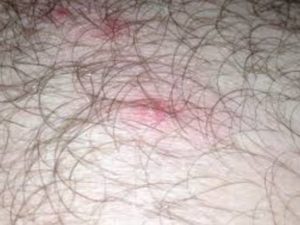
Infected hair follicle hard lump
A hard lump is a common symptom of an infected hair follicle. Other common symptom shown by infected hair follicle will include:
- A big swollen mass or lump on the skin especially under the armpit, around the groin.
- Inflamed and red skin
- Burning and itchy skin, this can be severe causing a contagious urge to scratch your skin
- Pain and tenderness on skin
Infected hair follicle pulled out
An infected hair follicle will most likely cause the blocking and clogging of the sebaceous gland. The hair follicle can then accumulate dead skin cells, sebum and pus. The clogging makes it harder for hair strands to penetrate out of the skin. This is how an ingrown hair is formed.
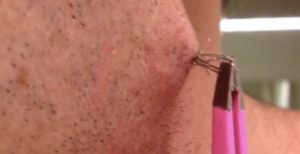
According to folliculitis clinic.com, some of the first signs of an ingrown hair are a tingling, itching feeling. With time, you are able to see redness and swelling. A pustule or papule with a hair located in the center is then. It shows an infected ingrown hair.
Ann ingrown hair cyst can be very painful, at times, it can also be deep inside skin in that it is impossible to extract with a pair of tweezers. To pull out an infected ingrown hair, a dermatologist may have to perfume a surgical procedure. With surgery, you are more likely to have a scar on the skin. Surgery also increases the chance of an infection. This is common when the surgical procedure is not done by a professional.
We advise against pulling out an ingrown hair at home. To understand how to get rid of an ingrown hair permanently, you need to first understand what the underlying cause of the ingrown hair or infected hair follicle is. The common cause of damaged hair follicles will include:
- Natural dry skin
- Occurrence of tightly curled hair
- Bacterial and fungal infection of the skin
- Shaving too close to the skin
- Skin irritation from chemical and skin care products
- Poor hair removal methods such as waxing and tweezing
Infected hair follicle removal
An infected hair follicle that results in an ingrown hair or a boil can be removed. Before attempting to remove an ingrown hair or popping a clogged hair follicle, you need be sure you do not suffer from any skin infection. If you do, then you risk spreading the infection to other parts of the body. Once you seek professional medical diagnosis, a dermatologist should be able to diagnose if you suffer from either a bacterial or yeast infection.
In cases of mild cases of bacterial infection, topical antibiotics will be prescribed for you. If the infection has spread to other parts of the body, then an oral antibiotic will be used. To remove an ingrown hair or an infected hair follicle:
- Wash your hands and the affected are with lukewarm water and a mild soap
- Using a pair of tweezer, gently pull out the tip of the hair of the ingrown hair
- Make sure to sterilize the tweezers by alcohol or fire to reduce the risk of infection
- For a persistent ingrown hair, just spot the tip and cut it
- Wash the affected are this time round with an antiseptic solution or an antibacterial cleanser, you can wash with cold water to close the hair follicle, this will also reduce pain.
- Keep your skin moist and flexible, drink plenty of fluid more specifically water to keep hydrated.
Infected hair follicle treatment
The treatment of an infected hair follicle will depend on what the extent of the bacterial or fungus infection is. To treat an infected hair follicle try the following:
Topical ointment
A topical ointment is on body creams and gel that will help relieve symptoms such as itching, irritation, burning sensation and the continuous urge to scratch. Topical ointment can also be applied on the body to reduce swelling and inflammation on the skin caused by the infection of the hair follicle.
Though most of them can be accessed over the counter, it is important to have them prescribed to you by a professional health care provider after a medical diagnosis.
Oral antibacterial pills
Oral antibiotics pills are in most cases used for severe bacterial infection of the hair follicles. Antibiotics can also be used to treat a wide range of bacterial infection. Due to the emergence of bacterial resistance, the clinic use of oral antibiotics is limited. The pills are more often used for severe cases of acne.
Corticosteroid
Corticosteroids are a group of steroid hormones produced by the adrenal cortex or made synthetically. They act as anti-inflammatories, by altering the mediators responsible for inflammation. Inflammation is one of the most common symptoms of hair follicle infection and an ingrown hair. Corticosteroids can also help relieve irritation and itching.
When not used correctly, most corticosteroids will have side effects, have a professional dermatologist or health care practitioner prescribe the medication for you.
Wash with antibacterial soap
For a popped or ruptured ingrown hair or infected hair follicle, you need to keep the area clean and free from the risk of either bacteria or fungal infection. Wash the area with an antibacterial solution and make sure to dry and keep it closed free from dirt.
Avoid irritating chemicals and skin care creams
With an infected hair follicle, avoid harsh soap and cosmetic or skin care products that might worsen the symptoms and give the urge to constantly scratch the skin. This way, you provide an enabling environment for healing and relieving pain and irritation.
Infected hair follicle home remedy
Some of the symptoms of an infected hair follicle can be managed and controlled at home with simple home remedies. To manage the infection, you can try the following:
Apply aloe Vera gel
Aloe Vera has been used for long now for different skin conditions. When applied on skin, aloe Vera may help bring down the irritation, itching, and inflammation caused by an ingrown hair on the skin. To prepare an aloe Vera remedy, squeeze the gel from aloe Vera leaves and apply it on the infected part of the skin.
O make an even more effective remedy, you can add a tablespoon of honey into the gel before applying it on skin.
Apple cider vinegar
To get rid of an ingrown hair on the skin you can also use apple cider vinegar. A warm solution of apple cider will help draw out an ingrown hair on any part of the skin.
- Soak a clean towel or cotton ball in some vinegar
- Hold it on the affected area for some minutes
- Repeat this twice or thrice and the ingrown hair will work its own way out
Apply hot or moist compress
Apply a warm compress on the ingrown hair bump between intervals. It will help bring down the swelling and itching. Reducing the swelling might help with pulling out the ingrown hair.
Other home care methods
To prevent hair follicle infection or spreading the infection to other people you will need to:
- Maintain Good personal hygiene
- Adopt Proper skin care
- Avoid sharing towels and other personal skin care products
- Don’t scratch the bumps and rash
- Wear loose-fitting clothing that give the skin room to breath
Sources and References
- http://www.webmd.com/skin-problems-and-treatments/tc/folliculitis-topic-overview#1
- http://www.ifd.org/protocols/bacterial-infections-of-the-hair-follicles
- http://www.newhealthadvisor.com/Infected-Hair-Follicle.html
- http://www.medicinenet.com/image-collection/folliculitis_picture/picture.htm
- http://www.mayoclinic.org/diseases-conditions/folliculitis/basics/symptoms/con-20025909
- http://www.nhs.uk/conditions/ingrown-hairs/Pages/Introduction.aspx
- https://en.wikipedia.org/wiki/Folliculitis
